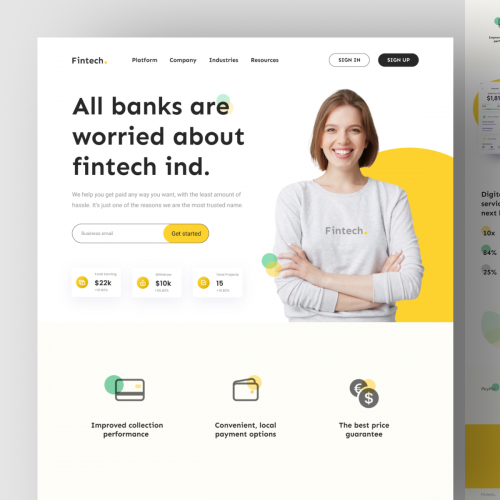Cutting-Edge Website Design Services with a Focus on User Experience
Cutting-Edge Website Design Services with a Focus on User Experience
Blog Article
Top Tips for Producing an Impactful Web Site Layout That Converts
To achieve this, one have to take into consideration a selection of variables, including recognizing the target audience, prioritizing customer experience, and maximizing for mobile systems. The tactical usage of compelling call-to-actions and a well-defined visual power structure plays a vital duty in assisting users with their journey.

Understand Your Target Market
Understanding your target market is basic to efficient website layout, as it prepares for producing an engaging customer experience. Identifying that your customers are, including their demographics, choices, and habits, makes it possible for designers to customize the web site's web content, layout, and functionality to satisfy particular requirements.
Performing extensive marketing research is important in this process. Studies, interviews, and analytics can provide useful understandings right into user assumptions and pain factors. By compiling this data, designers can produce customer identities that stand for various sections of the audience, making sure that style choices are notified and pertinent.
Additionally, understanding the target audience helps in selecting proper style components such as color pattern, typography, and images that reverberate with individuals. A site that talks straight to its audience cultivates a sense of connection and count on, motivating longer sees and greater conversion rates.
Ultimately, a user-centered method to website style not only improves user satisfaction however additionally sustains organization objectives by driving engagement and loyalty. By focusing on the demands and choices of the target market, an internet site can properly offer its objective and achieve desired results.
Prioritize Individual Experience
To boost the overall performance of a web site, prioritizing user experience (UX) is essential (Website Design). A well-designed UX makes sure that visitors can navigate the website easily, find info quickly, and engage with material meaningfully. This leads to raised user satisfaction and higher conversion rates
Begin by carrying out user-friendly navigation. Menus must be rationally structured, enabling users to situate essential areas of the website with minimal effort. Uniformity in design elements, such as color pattern and font styles, fosters experience, which is essential for maintaining user involvement.
Furthermore, consider the packing speed of your website. A delay of just a few seconds can cause substantial drop-offs, as users are much less likely to wait on a slow-loading page. Enhancing photos and optimizing code can improve performance and preserve site visitors.
In addition, clarity in content presentation is crucial. Use succinct, appealing language and separate text with visuals to improve readability. By prioritizing customer experience, you not just produce an extra enjoyable atmosphere for visitors yet additionally strengthen your brand's credibility. Inevitably, a focus on UX is a financial investment in the long-term success of your site.
Enhance for Mobile Devices
Enhancing for mobile tools is critical in today's electronic landscape, where an increasing variety of individuals gain access to web sites with smartphones and tablet computers. A mobile-friendly layout not just enhances individual experience but additionally plays a significant function in improving search engine rankings. To accomplish this, it is vital to adopt a receptive style that instantly gets used to various screen sizes and orientations.

Loading rate is one more important factor; mobile users are commonly less patient and anticipate fast access to info. By focusing on mobile optimization, you guarantee that your site continues to be affordable and properly engages a broader target market.
Use Engaging Call-to-Actions
A website's performance typically pivots on its capability to assist site visitors towards wanted actions, making engaging call-to-actions (CTAs) necessary components of layout. CTAs work as the essential points that route users to engage with the site, whether that implies making an acquisition, signing up for a newsletter, or downloading and install a source.
To produce efficient CTAs, quality is paramount. Usage succinct language that plainly communicates the action you desire the user to take. Phrases such as "Get going," "Join Free," or "Shop Now" not only convey seriousness however also get rid of ambiguity. The placement of CTAs is equally vital; they ought to be purposefully positioned throughout the website to guarantee they are quickly visible, specifically in high-traffic areas.
In addition, think about making use of directional cues, such as arrows or images, to resource lead individuals towards these buttons. By concentrating on these components, organizations can substantially boost individual engagement, driving conversions and ultimately attaining their check web site's objectives.
Concentrate On Visual Pecking Order
Efficient website design counts heavily on a well-structured aesthetic hierarchy that overviews users via content seamlessly. By arranging aspects in a manner that focuses on info, designers can boost user experience and facilitate decision-making. This involves using size, color, contrast, and spacing purposefully to attract focus to the most vital elements of a page.
The usage of larger font styles for headings and subheadings develops a clear distinction between different sections, permitting individuals to check content effortlessly. Additionally, using contrasting colors for switches and calls-to-action can capture individual interest and motivate communication. Whitespace is another vital component; it avoids mess and allows users to concentrate on essential messages without diversions.
Images and graphics must complement the text while likewise adhering to the well-known hierarchy, reinforcing the overall message (Website Design). Uniformity in style elements, such as color plans and typography, further reinforces the aesthetic hierarchy, making navigation instinctive

Conclusion
Finally, effective internet site design demands a thorough understanding of the target audience, prioritization of customer experience, and mobile optimization. The calculated usage of compelling call-to-actions and a well-defined aesthetic hierarchy additionally enhances customer involvement. By executing these concepts, websites can achieve greater conversion rates, making sure that style components not just bring in site visitors but likewise assist in smooth navigating and interaction. Eventually, a well-executed site design serves as a crucial component in driving user actions and achieving company purposes.
Report this page